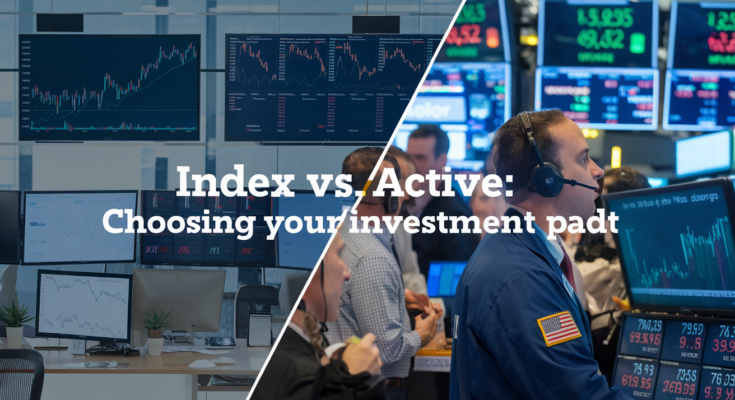🎢 Investing can feel like a rollercoaster ride, with countless options and strategies vying for your attention. But when it comes to building a solid portfolio, two contenders often stand out: index ETFs and actively managed funds. Which one should you choose? Is there a clear winner in this financial face-off?
The debate between passive and active investing has raged for years, with passionate advocates on both sides. Index funds offer the allure of low costs and broad market exposure, while actively managed funds promise the potential for market-beating returns. But here’s the kicker: over the past 15 years, only a small percentage of active fund managers have consistently outperformed their benchmarks. 🤔 So, is the extra cost and effort of active management worth it?
In this blog post, we’ll dive deep into the world of index ETFs and actively managed funds. We’ll explore their key differences, compare performance, and examine how they fit into a balanced portfolio. By the end, you’ll have a clearer picture of which approach might be better suited for your investment goals. Let’s embark on this financial journey and unravel the mystery of Index ETFs vs. Actively Managed Funds: Which Is Better?
Understanding Index Funds and ETFs
A. Definition and purpose
Index funds and ETFs (exchange-traded funds) are investment vehicles designed to provide diversified exposure to a range of assets at a low cost. Both aim to track the performance of specific market indices, such as the S&P 500, by investing in the same securities in similar proportions.
Key characteristics of index funds and ETFs:
- Passive management approach
- Low fees compared to actively managed funds
- Diversification across multiple securities
- Replication of market index performance
B. Passive management approach
Index funds and ETFs employ a passive management strategy, which involves:
- Minimal trading activity
- Lower operating expenses
- Reduced human intervention in investment decisions
This approach contrasts with actively managed funds, where fund managers attempt to outperform the market through frequent trading and security selection.
C. Replication of market indices
The primary goal of index funds and ETFs is to mirror the performance of their target indices. This is achieved through:
| Method | Description |
|---|---|
| Full replication | Holding all securities in the index in the same proportions |
| Sampling | Holding a representative subset of securities from the index |
By replicating market indices, these investment vehicles offer:
- Predictable returns aligned with overall market performance
- Broad market exposure
- Reduced risk associated with individual security selection
It’s important to note that while index funds and ETFs share many similarities, they differ in trading mechanisms and potential tax implications. ETFs can be traded throughout the day like stocks, offering greater flexibility, while index funds are priced once at the end of the trading day.
Now that we have covered the fundamentals of index funds and ETFs, let’s explore the contrasting approach of actively managed funds in the next section, “Actively Managed Funds Explained.”
Actively Managed Funds Explained
Now that we’ve explored index funds and ETFs, let’s delve into actively managed funds, which offer a different approach to investing.
Professional fund management
Actively managed funds are overseen by experienced professionals who make investment decisions on behalf of investors. These fund managers:
- Conduct in-depth research and analysis
- Use various strategies (fundamental, technical, quantitative)
- Aim to identify undervalued stocks or growth opportunities
- Adapt to changing market conditions
Dynamic portfolio adjustments
Unlike passive strategies, active management involves frequent adjustments to the portfolio. This approach allows managers to:
- Respond swiftly to market risks
- Employ hedging techniques
- Optimize asset allocation
- Tailor investments to fund goals
Aim to outperform benchmarks
The primary objective of actively managed funds is to surpass the performance of specified benchmarks. This goal is pursued through:
| Strategy | Description |
|---|---|
| Stock selection | Identifying potentially profitable securities |
| Market timing | Making buy/sell decisions based on market trends |
| Sector rotation | Shifting investments between different market sectors |
Active managers assess their success by comparing portfolio performance to relevant benchmarks. For instance, the Fidelity Blue Chip Growth Fund outperformed the Russell 1000 Growth Index over a five-year period.
While active management offers the potential for higher returns and flexibility in investment choices, it also comes with higher fees and reduced tax efficiency compared to passive funds. Investors should consider their goals, risk tolerance, and the fund manager’s track record when choosing between active and passive strategies.
With this understanding of actively managed funds, we’ll next explore the key differences between index and actively managed funds to help you make informed investment decisions.
Key Differences Between Index and Actively Managed Funds
Now that we’ve explored actively managed funds, let’s delve into the key differences between index and actively managed funds. These distinctions are crucial for investors to understand when making investment decisions.
A. Management style: passive vs. active
Index funds employ a passive management strategy, aiming to replicate the performance of specific market indices like the S&P 500. In contrast, actively managed funds rely on fund managers to hand-pick investments, attempting to outperform the market.
B. Cost structures and expense ratios
One of the most significant differences lies in the cost structures:
| Fund Type | Average Expense Ratio |
|---|---|
| Index Funds | 0.03% to 0.05% |
| Actively Managed Funds | 0.50% to 0.75% |
The lower costs of index funds are attributed to their passive management approach, which requires less frequent trading and lower operational expenses.
C. Performance predictability
Index funds offer more consistent returns aligned with their respective indices. Actively managed funds, while aiming for higher returns, often struggle to consistently outperform their benchmarks over the long term.
D. Risk profiles
- Index funds:
- Lower risk due to broader market exposure
- Subject to market fluctuations
- Actively managed funds:
- Potentially higher risk due to concentrated positions
- Risk varies based on manager’s strategy
E. Diversification levels
Both fund types offer diversification, but in different ways:
- Index funds provide instant diversification by holding a representative selection of securities within their target index.
- Actively managed funds may offer varying levels of diversification depending on the fund manager’s strategy and the fund’s objectives.
With these key differences in mind, next, we’ll examine the performance comparison between index ETFs and actively managed funds to help investors make informed decisions based on historical data and market trends.
Performance Comparison
Now that we have covered the key differences between index and actively managed funds, let’s delve into their performance comparison. This analysis will help investors make informed decisions based on historical data and long-term returns.
A. Historical data on benchmark outperformance
Historical performance data reveals a challenging landscape for active fund managers:
- Over the past 15 years, only a small percentage of active stock and bond fund managers have successfully outperformed their respective benchmarks.
- Between July 2023 and June 2024, approximately 51% of active funds outperformed their passive counterparts, showing a slight improvement from the previous year.
- However, over a decade, only 29% of active funds managed to beat the average indexed fund.
| Fund Type | 1-Year Success Rate | 10-Year Success Rate |
|---|---|---|
| Active Funds (Overall) | 51% | 29% |
| Active Real Estate Funds | 66% | N/A |
| Active Intermediate-Core Bond Funds | 72% | N/A |
| Active US Large-Cap Funds | N/A | 20% |
B. Challenges of active management
Active management faces several hurdles in achieving consistent outperformance:
- Market timing difficulties
- Asset selection challenges
- Competitive US large-cap market
- Underperformance in foreign equity and mid-cap funds
Despite these challenges, active management has shown success in specific areas:
- Real estate funds
- Intermediate-core bond funds
- Small-cap equity funds
C. Impact of fees on long-term returns
Fees play a crucial role in determining the long-term performance of funds:
- Active index funds typically incur higher management fees and transaction costs compared to traditional passive funds.
- These higher costs can negatively impact performance over time.
- The effectiveness of active management often depends on the manager’s ability to overcome these higher fees through superior stock selection and market timing.
It’s important to note that while some active funds justify their higher fees due to superior performance, the increasing preference for passive funds has led to a significant shift in asset allocation. As of 2024, assets in US passive mutual funds and ETFs surpassed those in active funds for the first time.
With this performance comparison in mind, next, we’ll explore how to build a balanced portfolio that leverages the strengths of both index and actively managed funds.
Building a Balanced Portfolio
Now that we’ve examined the performance comparison between index ETFs and actively managed funds, let’s explore how to build a balanced portfolio using both types of investments.
Using index funds as a foundation
Index funds provide a solid foundation for a balanced portfolio due to their low costs and broad market exposure. A typical balanced portfolio often follows a 60/40 allocation, with 60% in stocks and 40% in bonds. The Vanguard Balanced Index (VBINXT) exemplifies this classic approach, investing 60% in U.S. stocks and 40% in U.S. bonds. This strategy offers stability and growth potential, making it an excellent starting point for many investors.
Incorporating actively managed funds strategically
While index funds form the core, actively managed funds can be strategically added to enhance diversification and potentially boost returns. For instance, the T. Rowe Price Balanced (RPBAX) fund demonstrates how active management can provide additional benefits:
- Approximately 20% allocation to international stocks
- Inclusion of varied asset classes like real assets and high-yield bonds
- Target of 65% stock allocation for increased growth potential
Suggested allocation percentages
Here’s a suggested allocation table for a balanced portfolio:
| Asset Type | Percentage |
|---|---|
| U.S. Stocks (Index) | 40% |
| International Stocks (Active) | 20% |
| U.S. Bonds (Index) | 30% |
| Specialized Bonds (Active) | 10% |
This allocation combines the stability of index funds with the potential outperformance of actively managed funds in specific sectors.
Balancing stability and growth potential
To balance stability and growth potential, consider the following strategies:
- Use U.S.-focused index funds for core holdings
- Add actively managed international funds for global exposure
- Incorporate specialized bond funds for diversification
- Adjust allocations based on risk tolerance and investment horizon
For example, the BlackRock Global Allocation (MALOX) fund offers a comprehensive approach to global investing while maintaining a 60/40 benchmark. This type of fund can provide both stability and growth potential through expert management and diverse global exposure.
With this balanced approach in mind, next, we’ll examine the cost considerations of implementing such a portfolio strategy, as fees can significantly impact long-term investment returns.
Cost Considerations
Now that we’ve explored how to build a balanced portfolio, let’s delve into an equally crucial aspect of investment strategy: cost considerations. Understanding the financial implications of different fund types can significantly impact your long-term investment success.
A. Expense ratios of index funds vs. actively managed funds
When comparing index funds and actively managed funds, one of the most striking differences lies in their expense ratios. These costs can have a substantial effect on your investment returns over time.
| Fund Type | Typical Expense Ratio Range |
|---|---|
| Index Funds | 0.03% – 0.2% |
| Actively Managed Funds | 0.5% – 1.5% or higher |
As we can see, index funds generally offer much lower expense ratios due to their passive management approach. This cost efficiency is a key factor in their growing popularity among investors.
B. Long-term impact of fees on investment returns
The seemingly small difference in expense ratios can lead to significant divergences in long-term returns. For instance:
- A 1.60% expense ratio can reduce returns by approximately 30% over time
- Lower fees in index funds can result in superior long-term outcomes due to the compounding effect of returns
This compounding effect means that even a fraction of a percentage point in fees can translate to thousands of dollars in lost returns over an extended investment period.
C. Importance of cost efficiency in investment strategy
Given the substantial impact of fees on investment performance, cost efficiency should be a primary consideration when developing your investment strategy. Here are key points to remember:
- Scrutinize fund expense ratios before investing
- Be aware of additional fee structures, such as front-end and back-end loads
- Consider the trade-off between potential higher returns of actively managed funds and their increased costs
- Recognize that lower costs in index funds can lead to more predictable returns aligned with market performance
By prioritizing cost efficiency, investors can potentially enhance their overall returns and better position themselves for long-term financial success. Remember, every dollar saved in fees is a dollar that remains invested and working towards your financial goals.
Index ETFs and actively managed funds each offer unique advantages for investors. While index funds provide broad market exposure at low costs, actively managed funds offer the potential for outperformance through expert stock selection. The choice between these two approaches ultimately depends on an investor’s goals, risk tolerance, and investment strategy.
A balanced portfolio can benefit from incorporating both index ETFs and actively managed funds. By combining the stability and cost-efficiency of index funds with the growth potential of select actively managed funds, investors can create a diversified strategy that aims for long-term success. Remember to consider factors such as expense ratios, historical performance, and your personal financial objectives when making investment decisions. Ultimately, the key to successful investing lies in understanding your options and crafting a well-rounded portfolio that aligns with your individual needs and goals.




